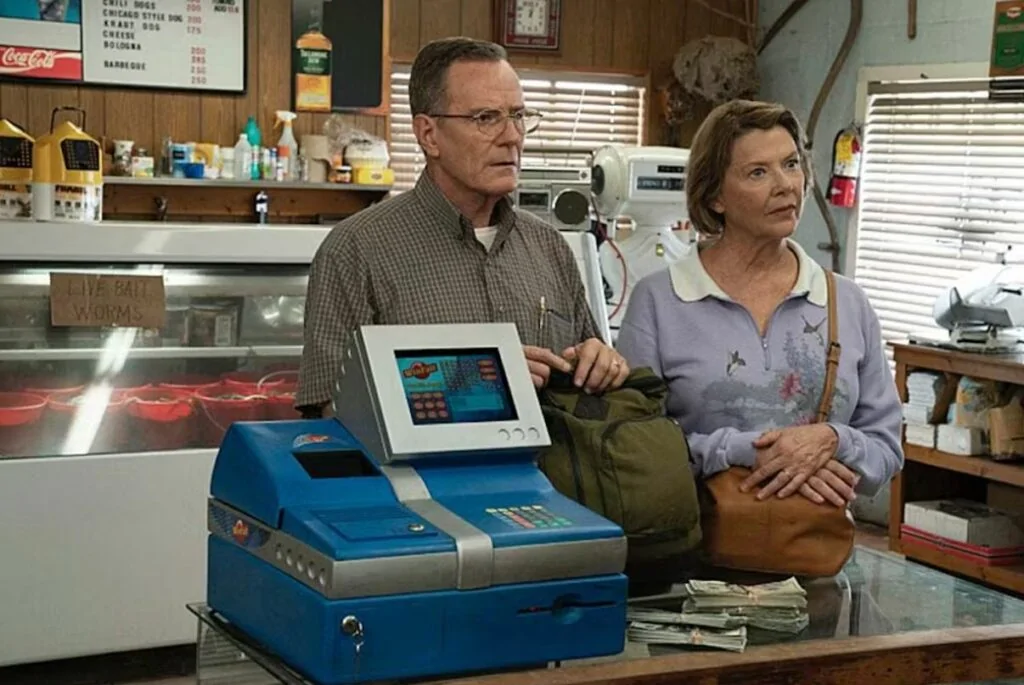The plot of Paramount+’s Jerry and Marge Go Large, which is based on the real-life experiences of Jerry and Marge Selbee, follows a retired couple from a small-town in Michigan who win millions after finding a mathematical lottery loophole that is entirely legal. In Evart, Michigan, the Selbees’ hometown with a total population of 1,900, Brad Copeland met with the Selbees, their family, and friends before writing the screenplay. The real-life high school sweethearts, who will commemorate 65 years of marriage this fall, even invited actors Bryan Cranston (Jerry) and Annette Bening (Marge) to spend a week with them.

After Jason Fagone’s article titled “The Lottery Hackers” from The Huffington Post, which served as the inspiration for Copeland’s script, was published in 2018, The Selbees’ remarkable tale received widespread attention. After selling the convenience store he later owned and retiring from his job at a Kellogg’s cereal factory, Jerry found out about the “Winfall” Michigan lottery game in 2003. In contrast to other games, this one had a “roll-down” feature that distributed the winnings to less fortunate players if no one had a perfect ticket.
Jerry, who graduated from Western Michigan University with a degree in mathematics, quickly calculated the odds and discovered that if he purchased enough tickets, he would definitely win money. He put his hypothesis to the test, and it was successful. In January 2019, he said to 60 Minutes correspondent Jon Wertheim, “It’s just basic arithmetic.”. He didn’t tell his wife about his lottery plans right away, but as soon as he shared his discovery and revealed that he had already won five figures, she was totally on board. They eventually formed a company called GS Investment Strategies LLC, kept meticulous records of their winnings, and invited a select group of friends to join them.
In May 2005, Michigan banned “Winfall,” but Jerry quickly discovered a Massachusetts game with a similar format called “Cash WinFall.”. As a result, the Selbees established a routine in which they would travel about 700 miles and purchase millions of tickets from two neighborhood convenience stores. The printing and sorting of them would take up to 10 hours per day for a period of 10 days. According to The Huffington Post, they generated more than $20 million in winning tickets sales by 2009, resulting in a net profit of $5 million after expenses and taxes.
The Selbees weren’t the only ones, though, and they soon started competing against, among others, a team of students from the Massachusetts Institute of Technology. Anomalies in the purchase of Cash WinFall tickets were reportedly known to the Massachusetts State Lottery. But the state announced they would phase out Cash WinFall within a year after a July 2011 Boston Globe investigative report exposed the money-making scheme, including that anyone who could spend at least $100,000 on tickets on a roll-down week was statistically assured a profit. To fill the gap, they set a daily cap of $5,000 on lottery retailer ticket sales.
Jerry and Marge last engaged in a game of Cash WinFall in January 2012. They earned nearly $27 million from both states over the course of nine years, along with their “shareholders,” bringing in about $7.75 million in profit before taxes. They never intended to lead a lavish lifestyle; instead, they used their money for useful purposes like helping their six children, 14 grandchildren, and 10 great-grandchildren pay for their education. The Selbees, who viewed playing the lottery as a hobby after retirement, also established a loan company that provided chances for others to expand their businesses or purchase homes.
Jerry later admitted to 60 Minutes that he didn’t think their story was as remarkable as everyone else does, calling their nearly $27 million earnings “satisfactory” but adding, “The only thing I found really remarkable is nobody else really seemed to grasp it.”. “.

